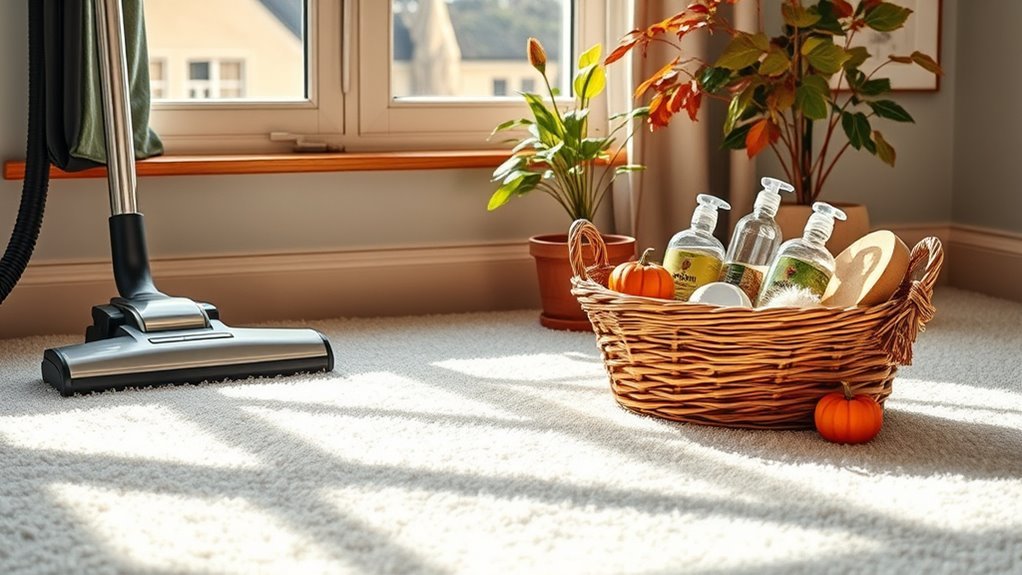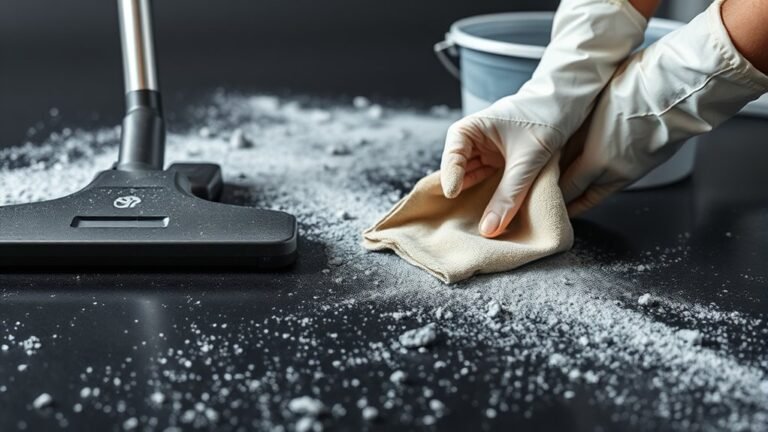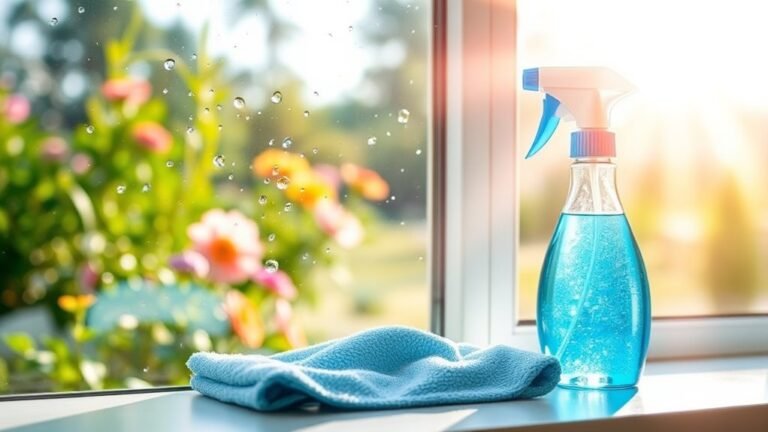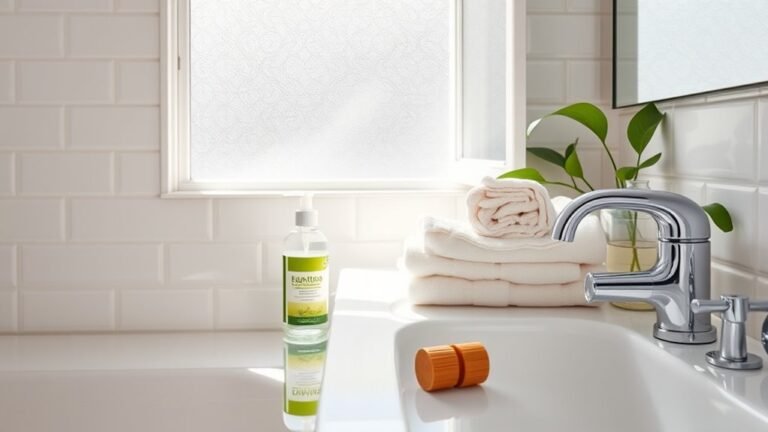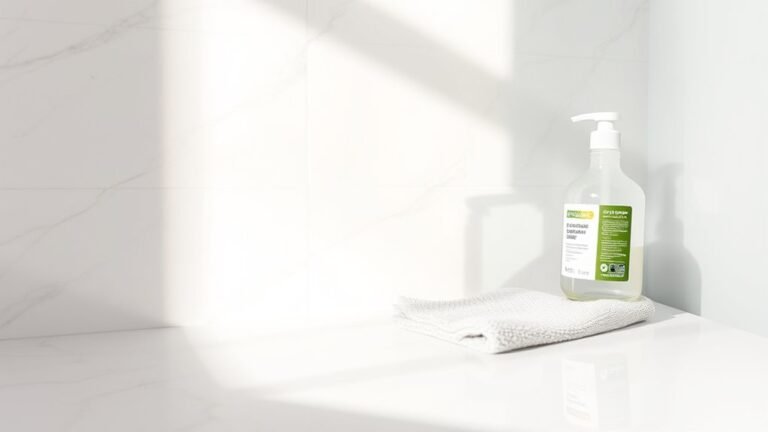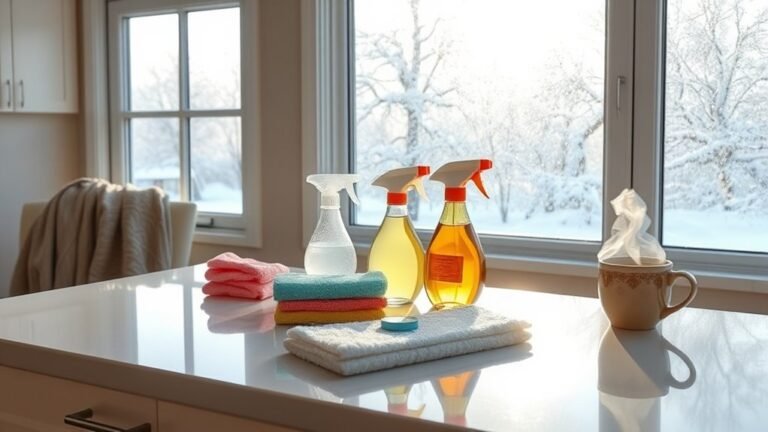Seasonal Maintenance Tips for Carpet
You should adjust your carpet care by season to keep it in top shape—vacuum more often in spring to remove pollen and fine dust, protect from UV damage in summer with window films, and use entry mats in fall to reduce debris. In winter, install moisture barriers and clean salt stains quickly to prevent damage. Regularly spot-clean stains and plan professional cleanings every 3–6 months for deep care. Explore tailored tips to maintain your carpet year-round.
Spring Cleaning Strategies for Carpets

Since spring often brings increased allergens and dirt indoors, it’s essential to adopt targeted cleaning strategies for your carpets. Begin with spring decluttering to remove items that trap dust and limit airflow around the carpet fibers. Use a high-efficiency vacuum with a HEPA filter, focusing on high-traffic areas to extract embedded particles. For carpet rejuvenation, apply a pH-neutral carpet shampoo or use steam cleaning, which penetrates deep to break down allergens and stains without damaging fibers. Guarantee thorough drying to prevent mold growth. Regularly rotate rugs to promote even wear and maintain texture. Implementing these precise techniques helps you maintain carpet integrity and indoor air quality, giving you freedom from allergens and a clean, vibrant floor surface throughout the season.
Summer Care Tips to Prevent Fading and Wear
After revitalizing your carpets for spring, summer introduces its own challenges that can accelerate fading and wear. To protect your carpet color, focus on UV protection and minimizing direct sunlight exposure. Use window treatments or UV-blocking films to shield your carpet, preserving its vibrancy longer. Regular vacuuming removes abrasive particles that cause fiber damage. Rotate rugs and furniture to distribute wear evenly, maintaining carpet integrity.
| Challenge | Solution | Benefit |
|---|---|---|
| UV Exposure | Window films/shades | Prevents carpet color fading |
| High Foot Traffic | Rotate rugs/furniture | Reduces uneven wear |
| Dirt & Debris | Frequent vacuuming | Protects fibers, extends life |
Fall Maintenance to Combat Dirt and Debris
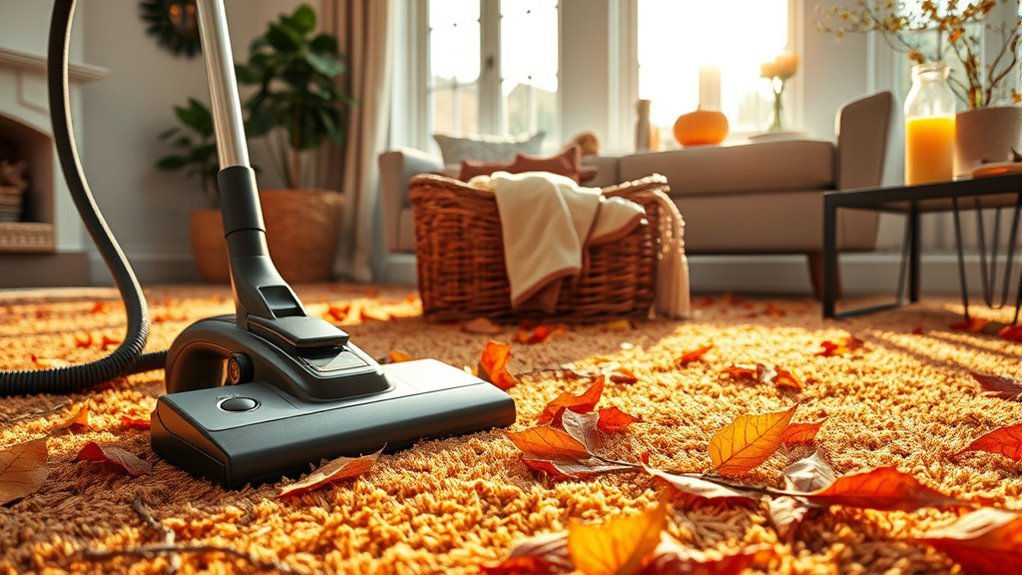
As fall brings increased mud, leaves, and moisture, you’ll need to prioritize pre-winter deep cleaning to remove embedded dirt and prevent staining. Using protective entry mats can greatly reduce tracked-in debris, preserving carpet fibers and extending lifespan. Focus on prompt removal of wet soil and organic matter to maintain carpet integrity throughout the season.
Pre-Winter Deep Cleaning
Before winter sets in, performing a thorough pre-winter deep cleaning is essential to protect your carpet from the increased dirt and debris tracked in during colder months. Start your pre winter preparation by vacuuming with a high-efficiency particulate air (HEPA) filter vacuum to remove fine dust and allergens embedded deep in the fibers. Follow with a professional-grade hot water extraction or steam cleaning to break down ground-in soil and stains without damaging carpet backing. This process restores fiber resilience and enhances carpet protection against moisture and abrasives common in winter. Pay special attention to high-traffic zones and entryways where contaminants accumulate. Conducting this deep cleaning before temperatures drop not only extends carpet life but also maintains indoor air quality, giving you the freedom to enjoy a clean, comfortable home throughout winter.
Tackling Mud and Leaves
Maintaining carpet cleanliness shifts focus as the seasons change, moving from deep cleaning to addressing the unique challenges posed by fall. Mud removal and leaf cleanup become essential to prevent dirt embedding and staining. To tackle these effectively, you should:
- Vacuum frequently to capture dry leaves and loose debris before they settle.
- Use a stiff-bristled brush to gently loosen dried mud, avoiding fiber damage.
- Apply a specialized enzymatic cleaner for organic stains from mud and decomposed leaves.
- Blot spills immediately with a microfiber cloth to prevent moisture absorption.
Protective Entry Mats
Entry mats serve as a critical first line of defense against the accumulation of dirt and debris in your home during fall. By strategically placing durable entry mats at all exterior doorways, you’ll trap soil, leaves, and moisture before they reach your carpet, greatly reducing wear and staining. The entry mat benefits include enhanced dirt containment, moisture absorption, and improved floor safety through slip resistance. To maximize effectiveness, select seasonal mat options designed specifically for fall conditions—these often feature coarse fibers to scrape debris and water-resistant backing to prevent moisture seepage. Regularly clean and rotate mats to maintain ideal performance. Implementing these targeted measures will help preserve your carpet’s integrity, offering you freedom from frequent deep cleaning and prolonging its lifespan throughout the challenging fall season.
Winter Protection Against Moisture and Salt Stains

Since winter introduces excess moisture and salt into your home, protecting your carpet from these elements is essential to preserving its integrity. Moisture barriers can prevent water from penetrating your carpet fibers, reducing the risk of mold and mildew. Salt damage, common from de-icing agents, can degrade carpet fibers and cause discoloration.
To shield your carpet effectively:
- Install moisture barriers under carpets in entryways.
- Use absorbent mats to trap salt and moisture before they reach your carpet.
- Promptly clean salt stains with a vinegar-water solution to neutralize salt buildup.
- Apply a protective carpet sealant designed to repel moisture and salt residues.
Regular Vacuuming Techniques for All Seasons
You’ll want to adjust your vacuuming frequency based on seasonal traffic and debris levels to prevent dirt buildup. Selecting the correct vacuum settings, such as brush height and suction power, guarantees effective cleaning without damaging fibers. Additionally, targeted techniques for removing seasonal dirt—like fine pollen in spring or gritty sand in summer—help maintain your carpet’s integrity year-round.
Vacuum Frequency Guidelines
Vacuuming your carpet at least twice a week is essential to maintain its appearance and prolong its lifespan. The frequency, however, should be tailored to your lifestyle, carpet fibers, and vacuum types. Here’s a practical guide:
- High-traffic areas demand daily vacuuming to prevent dirt buildup and fiber damage.
- Low-traffic zones can be vacuumed twice weekly to preserve fiber integrity without over-disturbing.
- Homes with pets require daily or every-other-day vacuuming to manage hair and dander accumulation.
- Seasonal changes affect dirt and moisture levels; increase frequency during fall and spring to combat allergens and debris.
Adjust these guidelines based on your vacuum’s efficiency and carpet fiber sensitivity, ensuring freedom from dirt without compromising your carpet’s condition.
Choosing Proper Vacuum Settings
Adjusting your vacuum settings according to your carpet type and seasonal conditions can greatly improve cleaning efficiency and protect the fibers. First, identify your carpet’s pile—low, medium, or high—and select a vacuum type accordingly. Upright vacuums with adjustable brush rollers work well for low to medium piles, while canister vacuums with gentle suction suit delicate or high-pile carpets. Next, optimize suction power: higher suction is ideal during heavy debris seasons like fall, but reduce it for fragile fibers to prevent damage. Many vacuums offer height adjustment; set it so the brush just contacts the carpet without excessive pressure. Using these tailored settings prolongs carpet life and enhances dirt removal without overexerting your vacuum. This precision lets you maintain your carpet’s appearance year-round, giving you the freedom to enjoy your space without worry.
Seasonal Dirt Removal Tips
Although dirt accumulation varies with the seasons, maintaining a consistent vacuuming routine is crucial to preserve your carpet’s integrity. Seasonal allergens and embedded dirt can degrade fibers if left unchecked. To enhance your carpet care, follow these practical vacuuming techniques:
- Increase vacuum frequency during high pollen seasons to reduce seasonal allergens.
- Use adjustable suction settings to handle varying dirt accumulation—from fine dust in spring to coarser debris in autumn.
- Vacuum slowly and methodically to guarantee deep dirt extraction from carpet pile.
- Regularly clean vacuum filters and brushes to maintain peak performance and prevent redepositing dirt.
Spot Cleaning Methods for Common Stains
When you notice a stain on your carpet, acting quickly can prevent it from setting and becoming harder to remove. For wine stains, immediately blot the area with a clean cloth to absorb excess liquid. Avoid rubbing, which can spread the stain. Apply a mixture of one tablespoon dishwashing detergent, one tablespoon white vinegar, and two cups warm water. Gently sponge the stain, then blot dry. For grease spots, sprinkle baking soda or cornstarch to absorb oil; let it sit 15 minutes, then vacuum. Next, apply a small amount of dish soap mixed with warm water, blotting until the grease lifts. Always test cleaning solutions on an inconspicuous area first, and use blotting motions rather than scrubbing to maintain your carpet’s fibers and freedom from damage.
When to Schedule Professional Carpet Cleaning
How often should you schedule professional carpet cleaning to maintain ideal appearance and hygiene? Following professional recommendations guarantees your carpet’s fibers stay healthy and free from embedded dirt. The scheduling frequency largely depends on usage, environment, and specific needs.
Consider these key factors:
- High-Traffic Areas: Clean every 3-6 months to prevent accumulation of grime.
- Pet Owners: Schedule every 3-4 months to address odors and allergens.
- Allergy Sufferers: Opt for quarterly cleaning to reduce irritants.
- General Maintenance: At least once a year for average household use.
Frequently Asked Questions
What Types of Carpet Fibers Are Best for High-Traffic Areas?
When choosing carpet fibers for high-traffic areas, you’ll want something with nylon durability since it resists wear and maintains its look over time. Nylon’s resilience means less frequent replacements, giving you freedom from constant upkeep. Polyester softness adds comfort but isn’t as tough under heavy use. So, if you need practicality and longevity, nylon is your best bet, while polyester suits lower-traffic spots where softness matters more.
How Do Humidity Levels Affect Carpet Longevity?
Think of your carpet like a sponge dancing in a humid jungle—too much moisture, and it starts to weaken and wear faster. You need effective humidity control to prevent mold, mildew, and fiber breakdown. Proper moisture management keeps your carpet fibers resilient, preserving texture and color. By maintaining balanced humidity levels, you guarantee your carpet lasts longer, freeing you from constant replacements and upkeep hassles.
Can Area Rugs Help Extend Carpet Life?
Using area rugs can definitely extend your carpet’s life by providing an extra layer of protection against foot traffic, spills, and dirt. The area rug benefits include reducing wear in high-traffic zones and minimizing direct exposure to sunlight, which fades carpet fibers. By strategically placing area rugs, you enhance carpet protection, preserving its appearance and structural integrity. This practical approach lets you maintain freedom in your design choices while safeguarding your flooring investment.
What Are Eco-Friendly Carpet Cleaning Options?
You can opt for eco-friendly carpet cleaning by using natural cleaners like vinegar, baking soda, and essential oils, which effectively break down dirt without harsh chemicals. Choose sustainable materials, such as biodegradable brushes or reusable microfiber cloths, to minimize waste. These options not only protect your indoor air quality but also reduce environmental impact. By adopting these practical, green methods, you’ll maintain your carpet’s appearance while enjoying freedom from harmful toxins and excessive waste.
How to Prevent Carpet Wrinkles and Buckling?
Like a well-fitted suit, your carpet needs proper stretching to avoid wrinkles and buckling. During carpet installation, ensuring the carpet stretching is done correctly is essential—it keeps fibers taut and prevents movement. To maintain freedom in your space, address any loose edges promptly and avoid heavy furniture dragging. Regularly check for moisture issues, as dampness can loosen the carpet backing, causing those unwanted ripples that limit your room’s flexibility.
